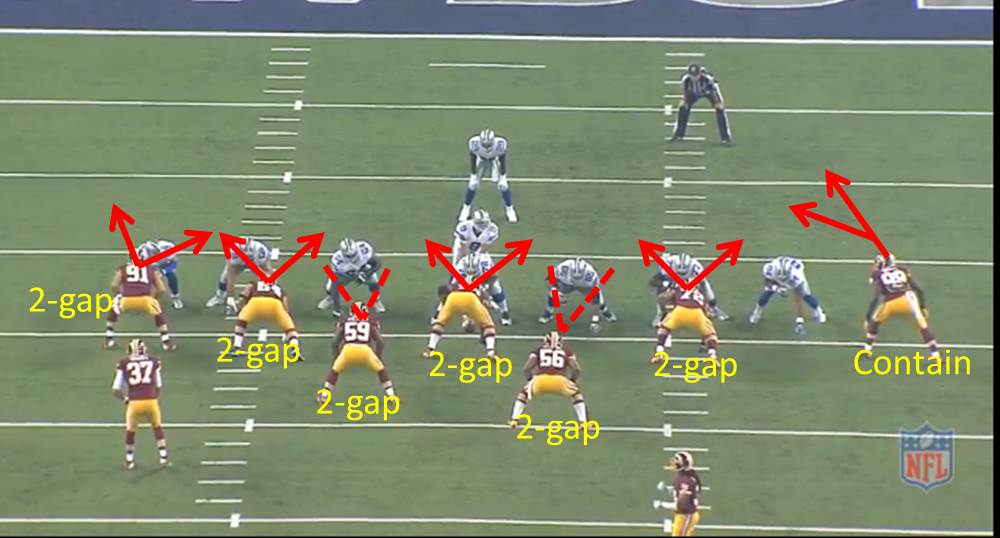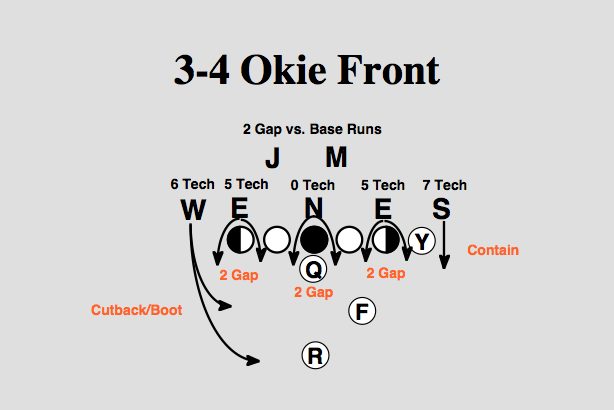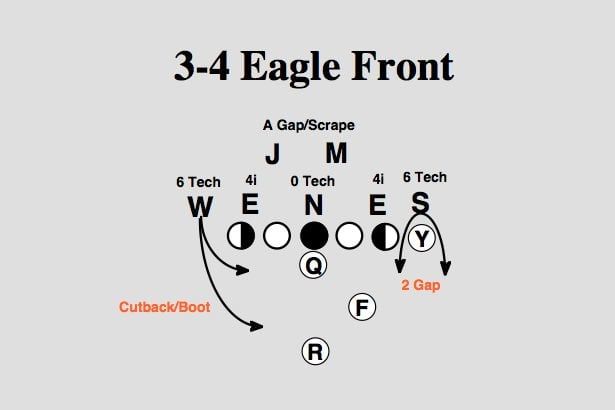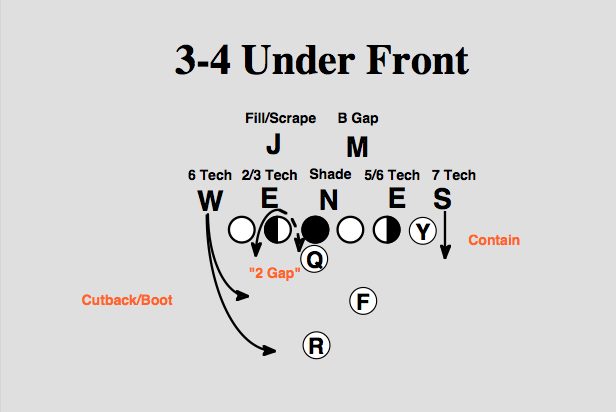SIKKEMA’S *SCHEME* OF THE WEEK PART II
“We’re on to 3-4” – Bill Belichick voice
On the previous page we gave an intro to defensive fronts, the importance of identifying gaps, how defenses can be aligned and what all that means for a 4-3 front. Now we’re going to discuss that for a 3-4.
Early in the 2016 season – as early as the preseason for that matter – Bucs fans saw defensive coordinator Mike Smith get pretty creative with how he used his pass rushers. It started with kicking defensive end Robert Ayers inside to defensive tackle on some plays and having the team stunt blitz with their four top pass rusher on one play. Then he started to do the same with defensive end William Gholston. As the injuries began to mount for the Buccaneers, the creativity was limited. But, as the offseason rolled around, we once again saw Smith and the rest of the Bucs organization think outside the box.
One of the premier signings for the Bucs this offseason was defensive lineman Chris Baker. Baker, who was a Top 20 interior defensive lineman last year according to Pro Football Focus, was praised as a quality signing by almost everyone. But, where acquiring the talent of Baker was a no-brainer, the wheels started turning as fans began to picture his impact in a Bucs uniform.
Baker was a part of a 3-4 defense in Washington, a defense that the Buccaneers do not play as a base scheme. As the offseason continued, the team drafted Stevie Tu’ikolovatu out of USC, primarily a nose tackle suited for a 3-4 defense. This all raised some questions and some eyebrows of intrigue.
All of the mysteries this offseason seemed to peak when Smith took the podium before the rookie mini-camp. In it, Smith said that his defense was on to the advanced stages of what they wanted to do, as opposed to starting from scratch like last year. He talked about being as versatile as possible as a front, and said he would use players like Baker and Tu’ikolovatu as 5-tech defense ends, as well as referenced pass rusher Noah Spence as a “three-down linebacker.”
PewterReport.com’s Scott Reynolds first signaled Spence’s possible position switch in an April SR’s Fab 5 column.
This caused Bucs fans to flood to the comments and message boards, offering their proposed thoughts and opinions on what the Buccaneers defense might look like in 2017 with all this 3-4 terminology being thrown around. We at PewterReport.com have been addressing this topic all throughout the offseason, and where we don’t think a complete scheme change is coming, it appears Smith is going to incorporate a lot more 3-4 characteristics than previously shown.
So, if that is, in fact, the case, what does that mean? Who plays where, and what is their role? With the knowledge of the Bucs’ 4-3 under out belt, let’s take a look at what goes into a 3-4.
Intro to 3-4
Still Gappin’
Whether it’s a 4-3, 3-4, 5-2 or 6-1 (just kidding, that last one only exists in my experimental NCAA video games), fronts are still about managing gaps. In a 4-3, the front seven has a one-gap mindset which makes things pretty simple, and is overall the easier form of front to run.
Since we now know what the numbers in scheme names mean, we know that a 3-4 calls for three down linemen with their hands in the ground and four linebackers. Two of the linebackers will be positioned in the same areas as the Mike and Will linebackers in a 4-3, the Sam linebackers will be up near the line of scrimmage on the tight end’s side, but then a fourth linebacker, called a Leo or Buck, will be aligned far outside the right tackle in a 6-, 7- or 9-tech position, used purely as a pass rusher or contain player.

The biggest difference between the 4-3 and 3-4 comes in where the defensive linemen line up and what their responsibilities are since controlling the gaps is still priority number one. In a 4-3, though sometimes players like the nose tackle and strong side defensive end will take on double teams or watch multiple gaps, their starting point comes from one gap, as it does for the rest of the front seven.
In a traditional 3-4, a defensive lineman’s starting point comes from watching two gaps.
When thinking about the personnel for a 3-4, all three defensive linemen have to have size, length and strength. You can’t win in a 3-4 with a 6-foot-2, 260-pound defensive end; they’ll get bullied at the point of attack which will open up gaps. Instead, you’re looking for players like J.J. Watt, Calias Campbell or Casey Heyward. These are players who are massive in size and in length that take up as much space as possible. Essentially, these players have to be big enough to cover those two gaps, hence the 2-gap scheme. The point of having these 2-gap assignments is to free up the outside linebackers, giving them one-on-one opportunities to win on the edge with speed. These are players like Von Miller, Melvin Ingram and Brian Okrakpo.
Here’s what that looks like on the field.

The screenshot above is a traditional 3-4 look with no variation to it. It shows the potential gap assignment in 2-gap form for each player in the front seven, though not every player is going to have a 2-gap responsibility, even on traditional plays.
But that’s when things are straight up old school, and just like we explained in a 4-3, as offenses have come to evolve, defensive front have to keep up and adjust. Because of that, there are three different kinds of 3-4 fronts that can be used in today’s NFL: Okie, Eagle and Under. Each of these fronts attack and contain an offense in different ways, and call for different uses of personnel.
“Okie” Front

(via Bleacher Report)
A 3-4 “Okie” front is the closets thing to a traditional 3-4 there is. In it, all three of the down linemen are responsible for two gaps. Because of this, the defensive ends are line up as 5-tech players directly in front of the offensive tackles and the center is line up directly in front of the center. This way, if the ball goes to their left or right, they can have the easiest path to fill a gap. This is why both size and strength are key for 3-4 defensive ends. they have to be able to hold their line and be patient to see where a run play is going, then be able to rip off their block to the left or right once the ball carrier makes his decision.
In theory, the outside linebackers would then only have to play contain on the edge and keep a running back from bouncing to the outside, while the two inside linebackers would be free to either shoot a gap as a pass rusher or fill a gap in run support.
So, what would playing an “Okie” alignment look like for the Buccaneers? Well, it would feature Gerald McCoy and William Gholston as the 5-tech defensive ends with Stevie Tu’ikolovatu or Sealver Siliga as the 0-tech nose tackle, then Chris Baker and Clinton McDonald as interchangable players at either spot. It would then use Spence, Ayers or Jacquies Smith as the Leo pass rusher and Kendell Beckwith or Devante Bond as the Sam with David and Alexander in the middle.
Personnel wise, not bad. It could work, but asking McCoy to 2-gap as a base formation would be somewhat of a waste, and asking Gholston to 2-gap might also come back to bite them. He holds the run fine as a defensive end in a 4-3, but a 3-4 would take a lot of strength for a guy who is 280 pounds.
On another thought, many people like the ideal of the Buccaneers playing a 3-4 as a means for the team to stay creative when McCoy is getting a rest. If that’s the case, the “Okie” front makes more sense with Baker, Gholston or McDonald as the defensive ends and Tu’ikolovatu and Siligia as the 0-tech options.
Let’s move on.
“Eagle” Front

(via Bleacher Report)
The “Eagle” front is one that is much more common than the “Okie” front just because it involves a hybrid of 2-gap and 1-gap responsibilities.
In an “Eagle” front, the 2-gap player is the one who is lined up directly over the tight end on the strong side. Instead of the Sam linebacker playing contain on the outside in a wide 7-tech position like in an “Okie” front, that player is instead right over the tight end as a 6-tech as so he can break to either side if needed. Because of this, the defensive ends align themselves sightly further inside on the shoulders of the offensive tackles, rather than right in front of them. This means they are only responsible for one gap, the gap directly in front of them.
This style of a 3-4 seems more ideal for the Buccaneers just because it would allow McCoy to play in a one-gap position again (though not at 3-tech) and would, in theory, get the most of Beckwith as a bigger Sam linebacker. Beckwith as the 2-gap player means the interior defensive linemen can focus more on penetrating the pocket – as could Spence on the weak side.
“Under” Front

(via Bleacher Report)
The “Under” front for a 3-4 defense once again gives a mix of 2-gap and 1-gap assignment, but shifts the responsibility a bit.
For an “Under” front, it’s one of the defensive ends that takes the 2-gap work from the 2- or 3-technique. Initially you’d think this would be McCoy because it would allow him to go back to his natural 3-tech position. However, without predetermined help from one of the middle linebackers (which can be arranged), he’d be more of a run stuffer from that spot.
Alternatively, the team could send Baker on the weak side as the 3-tech, 2-gap player and leave McCoy on the strong side as a 5- or 6-tech player, but that’s pretty far out for him. That would be a position you’d probably rather see from a player like Robert Ayers.
Recap: Pros and Cons
So, now that we understand the alignment and responsibilities of a 3-4 defense, let’s recap how it might look with this Buccaneers roster with some pros and cons.
The pros for this would be in its versatility. With Spence trimming down and getting faster, it makes sense to get the most of him as a speed player. Using Spence as a stand-up speed rusher on the weak side while the defensive line is taking up as many gaps as possible instantly makes him the focal point of the defensive line in such a formation. If the opposing team has a right tackle who is struggling, calling the “Eagle” front could result in a multi-sack day for Spence.

Bucs LBs Lavont David & Kwon Alexander – Photo by: Mark Lomoglio/PR
The pros also lie in the rest of the linebacker group. With David and Alexander being as athletic as they are, they would be able to shoot gaps in the pass rush and really rack up the sacks and tackles for loss, in theory. It would also get the most out of Kendell Beckwith, when healthy, since he has the size to set the edge and pass rush.
Finally, there are pros in getting the most out of Baker, Tu’ikolovatu and Ayers as versatile linemen. Calling any variation of the 3-4 front would allow them to stay versatile and creative with how they attack the pocket. Those three are also athletic enough to be successful on stunt blitzes when switching spots.
The cons for a 3-4 are based on McCoy and what you do with him. If the team is using this 3-4 alignment to make plays when McCoy is resting, I have no problem with that, and, in fact, could be a great idea. But, when McCoy is on the field, lining him straight up with an offensive lineman is a waste of his quickness. Asking him to hold double teams is also not ideal, not because he can’t do it, but it’s like having a Ferrari and only driving it in the city with stop-and-go traffic.
A 3-4 might also put the team in an awkward spot depending on how long Beckwith is hurt. If Bond is the starting Sam linebacker, he might get pushed around a bit as the strong side player in a 3-4. It’s true that he would have some of the same responsibilities and concerns in a 4-3, but in a 3-4 he would have to set the edge by himself.
For the Spark Notes version: running a 3-4 would be asking McCoy to take on a lesser role (if he was on the field), which is fine, just know what you’re giving up by not running a 4-3. Plus it would be asking Spence to take a major jump as a pass rusher from what we saw in 2016. McCoy’s impact would be shifted over to him, and he would really have to shine. If Spence really gets going, I can see them possible using a 3-4 look to get him in even better situations. But, only if the interior linemen can hold those blocks.
Click the next page to see our Read-Option question for the week.
Trevor Sikkema is the Tampa Bay Buccaneers beat reporter and NFL Draft analyst for PewterReport.com. Sikkema, an alumnus of the University of Florida, has covered both college and professional football for much of his career. As a native of the Sunshine State, when he's not buried in social media, Sikkema can be found out and active, attempting to be the best athlete he never was. Sikkema can be reached at: [email protected]




